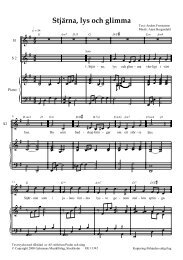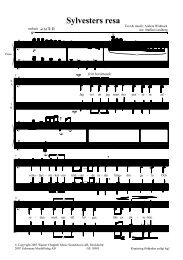Veli-Matti Puumala The music is the man - Gehrmans Musikförlag
Veli-Matti Puumala The music is the man - Gehrmans Musikförlag
Veli-Matti Puumala The music is the man - Gehrmans Musikförlag
Create successful ePaper yourself
Turn your PDF publications into a flip-book with our unique Google optimized e-Paper software.
Composer <strong>Veli</strong>-<strong>Matti</strong> <strong>Puumala</strong><br />
(b. 1965), Professor at <strong>the</strong> Sibelius<br />
Academy and winner of <strong>the</strong> prestigious<br />
Finn<strong>is</strong>h Teosto Prize, has set out to alter<br />
our concept of time. In h<strong>is</strong> <strong>music</strong>, <strong>the</strong><br />
seconds measured by <strong>the</strong> clock fuse with<br />
an inner, empirical perception of time.<br />
Photo: Music Finland/Saara Vuorjoki<br />
<strong>Veli</strong>-<strong>Matti</strong> <strong>Puumala</strong><br />
– a master of time<br />
As one of h<strong>is</strong> pupils, I have been in a position to<br />
engage in some profound conversations with <strong>Veli</strong>-<br />
<strong>Matti</strong> <strong>Puumala</strong> on sometimes surpr<strong>is</strong>ing subjects.<br />
One day, for example, it was – ice-hockey. I had<br />
been sneering at Finland’s national sport in <strong>the</strong><br />
<strong>man</strong>ner of a true cultural snob when he looked at<br />
me and said: “Ice-hockey’s a fine game. It moulds<br />
your concept of time. Minutes can pass without<br />
anything really happening, and <strong>the</strong>n suddenly<br />
every thing <strong>is</strong> electrified for five seconds and someone<br />
scores a goal.”<br />
L<strong>is</strong>tening to <strong>Puumala</strong>’s <strong>music</strong> likew<strong>is</strong>e moulds<br />
our concept of time. At <strong>the</strong> most magical moments,<br />
time ceases to have any meaning, <strong>is</strong> transformed<br />
into a nocturnal fragrance as in <strong>the</strong> closing Tra le<br />
braccia della notte movement of h<strong>is</strong> piano concerto<br />
Seeds of Time .<br />
A concerto of <strong>man</strong>y dimensions<br />
Seeds of Time was born in 2004 as a joint comm<strong>is</strong>sion<br />
from <strong>the</strong> Oulu, Helsingborg, Sjaelland<br />
and Stavanger orchestras. Premiered with Swed<strong>is</strong>h<br />
virtuoso Roland Pöntinen as <strong>the</strong> solo<strong>is</strong>t, it was<br />
an immediate success and won <strong>Puumala</strong> <strong>the</strong> Teosto<br />
Prize for 2005. A large-scale work lasting 40 minutes,<br />
it poses no small challenge for its performers<br />
but its astounding originality makes it all <strong>the</strong> more<br />
rewarding.<br />
<strong>The</strong> <strong>music</strong>al motifs of th<strong>is</strong> concerto are drawn<br />
from <strong>the</strong> most varied of worlds: modern<strong>is</strong>tic filaments<br />
of sound, piano textures with a whiff of<br />
Ro<strong>man</strong> tic<strong>is</strong>m, even 1950s jazz. In <strong>Puumala</strong>’s case<br />
<strong>the</strong>se are not just styl<strong>is</strong>tic allusions; <strong>the</strong>y are a<br />
means of creating several superimposed concepts<br />
of time. Now and <strong>the</strong>n, as right at <strong>the</strong> beginning<br />
of <strong>the</strong> concerto, time comes to a complete halt in<br />
static “windows”. According to <strong>Puumala</strong>, <strong>the</strong>se<br />
afford a view of a different time that stands still<br />
and does not move.<br />
Ano<strong>the</strong>r thing that fascinates <strong>Puumala</strong> <strong>is</strong><br />
space. For <strong>man</strong>y of h<strong>is</strong> orchestral works, <strong>the</strong><br />
players can be placed unconventionally, thus<br />
gene rating new aural impressions. <strong>The</strong> chamber<br />
orchestra for Seeds of Time cons<strong>is</strong>ts of small<br />
groups of instruments from different families<br />
playing material that <strong>is</strong> to a greater or lesser degree<br />
uniform. For <strong>the</strong> perfor<strong>man</strong>ces conducted by<br />
Susanna Mälkki <strong>the</strong> players sat in small groups,<br />
whereas Hannu Lintu preferred a traditional<br />
seating arrangement. In o<strong>the</strong>r words, <strong>the</strong> conductor<br />
<strong>is</strong> free to choose.<br />
Timelessness in twelve minutes<br />
Mure (2008), composed for <strong>the</strong> Ensemble intercon<br />
temporain and Susanna Mälkki in 2008,<br />
divides <strong>the</strong> chamber orchestra into two groups.<br />
Again, superimposed time planes are what interest<br />
<strong>Puumala</strong>. <strong>The</strong> flowing runs in <strong>the</strong> “controlled<br />
chaos” of <strong>the</strong> opening section are counteracted by<br />
assertive comments from <strong>the</strong> brass and interjections<br />
evocative of hi-hat jazz. <strong>The</strong> <strong>music</strong> arrives<br />
at an unavoidable dead-end and a dramatic<br />
silence broken by two bass-drum beats. An e<strong>the</strong>real,<br />
<strong>Puumala</strong>-<strong>is</strong>h ep<strong>is</strong>ode <strong>the</strong>n follows in which all<br />
sense of time van<strong>is</strong>hes before stealthily returning<br />
to a more active world. For <strong>Puumala</strong>, <strong>the</strong> journey<br />
from time to timelessness <strong>is</strong> not impossible even in<br />
a work lasting only 12 minutes.<br />
Notwithstanding h<strong>is</strong> infinite attention to<br />
detail, <strong>Puumala</strong> also exploits <strong>the</strong> potential of a<br />
large orchestra. Rope, premiered by <strong>the</strong> Finn<strong>is</strong>h<br />
Radio Symphony Orchestra under Hannu<br />
Lintu in 2012, <strong>is</strong> scored for triple woodwinds,<br />
a large brass section, strings, and a big battery<br />
of percussion instruments complete with piano<br />
and harp. <strong>The</strong> title evokes images of tight-rope<br />
walking, but also of <strong>the</strong> sturdy ropes that fasten<br />
ships. Once <strong>the</strong> stormy swell has abated, string<br />
and brass waves shot with micro-intervals rock<br />
<strong>the</strong> boat like heavy rollers from a d<strong>is</strong>tant ocean.<br />
Delicate portraits of mourning<br />
Ever since <strong>the</strong> 1990s, <strong>the</strong> <strong>music</strong> of <strong>Puumala</strong> has<br />
often incorporated a modal element. <strong>The</strong> little<br />
town, Kaustinen, where he was born hosts a big<br />
folk <strong>music</strong> festival, and some may catch echoes of<br />
th<strong>is</strong> in h<strong>is</strong> modern<strong>is</strong>t idiom. Composed for <strong>the</strong><br />
Ostro bothnian Chamber Orchestra in 2008,<br />
Memorial Fragment breaks folk <strong>music</strong> elements<br />
down into <strong>the</strong>ir tiniest components. Little folkfiddle<br />
pieces float like motes into a void, where <strong>the</strong>y<br />
are d<strong>is</strong>torted into a delicate portrait of mourning.<br />
Scored for string orchestra, Memorial Fragment<br />
<strong>is</strong> a tribute to ano<strong>the</strong>r Kaustinen composer, Pehr<br />
Henrik Nordgren (1944–2008).<br />
One of <strong>the</strong> most recent works by <strong>Puumala</strong> <strong>is</strong><br />
Tear, premiered by <strong>the</strong> Tapiola Sinfonietta in<br />
March 2013. <strong>The</strong> name, he says, reflects tearing<br />
strands woven into thin, rough, rustling textures.<br />
It also calls to mind ano<strong>the</strong>r meaning of <strong>the</strong> word:<br />
deeply personal, tearful emotions. Players in <strong>the</strong><br />
medium-sized chamber orchestra are also singled<br />
out as solo<strong>is</strong>ts as <strong>the</strong> work proceeds.<br />
<strong>The</strong> line of orchestral compositions, starting<br />
with <strong>the</strong> early Tutta via (1993) and continuing<br />
with such works as Chainsprings (1995–<br />
1997) recently released on CD by Alba along<br />
with Seeds of Time, has seen some weighty additions<br />
in <strong>the</strong> past few years. <strong>Veli</strong>-<strong>Matti</strong> <strong>Puumala</strong><br />
has rapidly become one of <strong>the</strong> leading Finn<strong>is</strong>h<br />
composers of orchestral literature.<br />
L a u r i M ä n t y s a a r i<br />
Footnote:<br />
<strong>Puumala</strong>’s latest orchestral work Rime was premiered on<br />
20 September by <strong>the</strong> Ostrobothnian Chamber Orchestra<br />
and Tuomas Hannikainen.<br />
H i g h l i g h t s 3 / 2 0 1 23


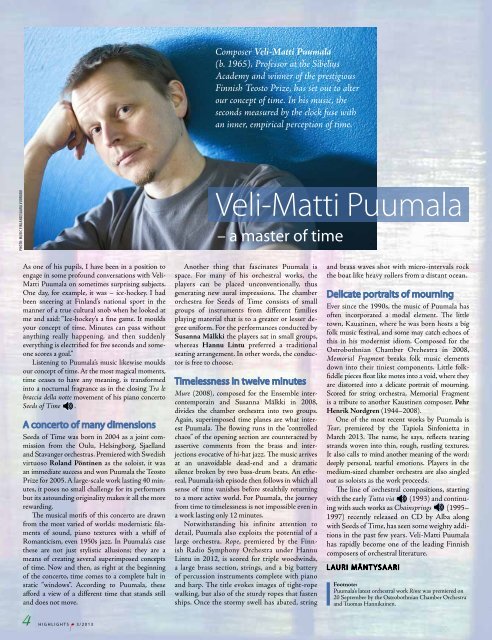
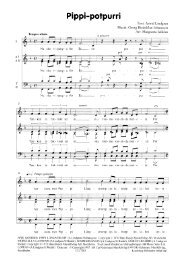

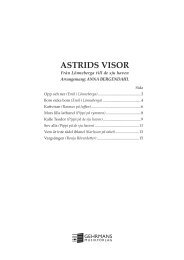
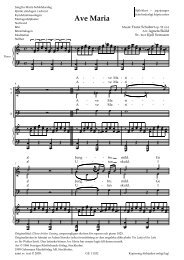





![Finale 2008a - [Lyssna, Gläd dig korr1.MUS] - Gehrmans Musikförlag](https://img.yumpu.com/38933790/1/184x260/finale-2008a-lyssna-glad-dig-korr1mus-gehrmans-musikfarlag.jpg?quality=85)
